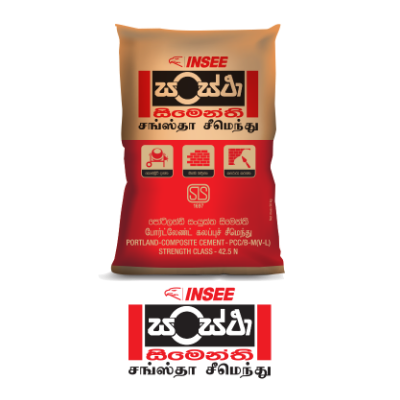
INSEE Mahaweli Marine Plus
High Strength Concrete
INSEE Mahaweli Marine Plus is a high strength Portland Composite Cement of either Ground Granulated Blast Furnace Slag or fly ash variants available for the first time in the local retail market.
Now with SLS 1697 certification Mahaweli Marine Plus is available in the market as composite cement to be sued in the harshest of environments for small and medium residential construction projects and other stakeholders as Concrete Products Manufactured (CPM) in the retail market. The versatility, strength and durability of the concrete mix has made INSEE MAHAWELI MARINE PLUS highly attractive to the local market that is responsibly contributing to sustainable construction practices.
Fact File
| Name : | INSEE Mahaweli Marine Plus |
| Type : | Portland-Composite Cement |
| Sri Lankan Standard : | SLS 1697:2021 |
| Strength Class : | 42.5N |
| British Standard: | BS EN 197 CEM II-B/M |
Properties
| PROPERTY | SLS 1697:2021 Requirement | INSEE MAHAWELI MARINE PLUS Average |
| PHYSICAL PROPERTIES | ||
| Compressive Strength (2 days) | ≥ 10 N/mm2 | ≥20 N/mm2 |
| Compressive Strength (28 days) | 42.5 – 62.5 N/mm2 | ≥ 52 N/mm2 |
| Setting Time | ≥ 60 minutes | 130 – 150 minutes |
| Fineness | Not Specified in Standard | 400 – 420 m2/kg |
| Soundness | < 10 mm | < 1 mm |
| Relative Density | Not specified in standard | 2.96 |
| CHEMICAL PROPERTIES | ||
| SO3 | ≤ 3.0 % | < 2.8% |
| Chloride | ≤ 0.1 % | < 0.05% |
| LOI | Not specified in standard | < 3.0% |
Compatibility
INSEE MAHAWELI MARINE PLUS is compatible with:
- Chemical Admixtures complying with BS EN 934-1:2008 and ASTM C494
- Fly Ash complying with BS EN 450
- Ground Granulated Blast Furnace Slag (GGBFS) complying with BS EN 15167-1:2006
- Silica Fume complying with BS EN 13263-1:2005+A1:2009
- Manufactured Sand (M-Sand) complying with BS EN 12620:2013
- Natural Sand, Quarry Sand and Offshore Sand complying with BS EN 12620:2013
Applications
INSEE MAHAWELI MARINE PLUS is used for:
- Residential concrete applications such as footings, basement walls, basement floor slabs, sidewalks, driveways, and garages
- Precast and Concrete Products Manufactured (CPM)
- Concrete roads
- Masonry and decorative constructions due to superior workability with a smoother and aesthetic finish
Features and Benefits
High Strength Concrete
Both slag and fly ash variants of INSEE MAHAWELI MARINE PLUS display inherent chemical properties that improves resistance over time, thanks to the pozzolanic reaction between the free lime of the hydration of the clinker and the active siliceous in the fly ash and slag with the formation of more calcium silicate hydrate. This result in a denser concrete with enhanced strength for concrete structures and highly appreciated by concrete blocks producers and prefabricated concrete elements.
Highly Durable Concrete
Slag and fly ash have inherent chemical properties that produce denser concrete with low permeability. By decreasing bleed channels, capillary channels and void spaces in the concrete, INSEE MAHAWELI MARINE PLUS lowers permeability of the concrete, reducing the potential for corrosion of reinforcing steel, adding further durability to building structures.
Better Finish / Less Efflorescence
The enhanced workability of INSEE MAHAWELI MARINE PLUS ensures improved, smoother and aesthetically pleasing surface finishing of concrete structures and applications. This in addition to the inherent sulphate resisting property in both fly ash and slag variants, results in less efflorescence – crystalline salt deposits – forming on the uniform concrete surfaces.
Cost Efficient
The high strength developed in concrete produced with INSEE MAHAWELI MARINE PLUS allows for a large reduction of admixture and cement consumption in the mix, reducing raw material costs to a great extent. It also leads to optimized structural design that allow for thinner, lighter and fewer structural elements. The optimized mix designs also result in curling and heat, less shrinkage and lowering life cycle costs, through increased service life.









